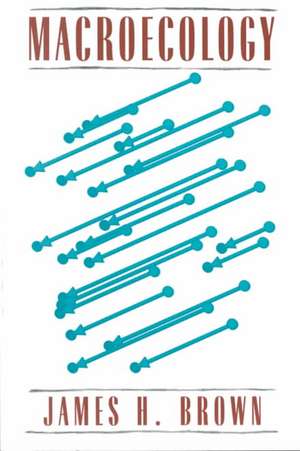Macroecology
Autor James H. Brownen Limba Engleză Paperback – iun 1995
In Macroecology, James H. Brown proposes a radical new research agenda designed to broaden the scope of ecology to encompass vast geographical areas and very long time spans.
While much ecological research is narrowly focused and experimental, providing detailed information that cannot be used to generalize from one ecological community or time period to another, macroecology draws on data from many disciplines to create a less detailed but much broader picture with greater potential for generalization. Integrating data from ecology, systematics, evolutionary biology, paleobiology, and biogeography to investigate problems that could only be addressed on a much smaller scale by traditional approaches, macroecology provides a richer, more complete understanding of how patterns of life have moved across the earth over time. Brown also demonstrates the advantages of macroecology for conservation, showing how it allows scientists to look beyond endangered species and ecological communities to consider the long history and large geographic scale of human impacts.
An important reassessment of the direction of ecology by one of the most influential thinkers in the field, this work will shape future research in ecology and other disciplines.
"This approach may well mark a major new turn in the road in the history of ecology, and I find it extremely exciting. The scope of Macroecology is tremendous and the book makes use of its author's exceptionally broad experience and knowledge. An excellent and important book."—Lawrence R. Heaney, Center for Environmental and Evolutionary Biology, the Field Museum
While much ecological research is narrowly focused and experimental, providing detailed information that cannot be used to generalize from one ecological community or time period to another, macroecology draws on data from many disciplines to create a less detailed but much broader picture with greater potential for generalization. Integrating data from ecology, systematics, evolutionary biology, paleobiology, and biogeography to investigate problems that could only be addressed on a much smaller scale by traditional approaches, macroecology provides a richer, more complete understanding of how patterns of life have moved across the earth over time. Brown also demonstrates the advantages of macroecology for conservation, showing how it allows scientists to look beyond endangered species and ecological communities to consider the long history and large geographic scale of human impacts.
An important reassessment of the direction of ecology by one of the most influential thinkers in the field, this work will shape future research in ecology and other disciplines.
"This approach may well mark a major new turn in the road in the history of ecology, and I find it extremely exciting. The scope of Macroecology is tremendous and the book makes use of its author's exceptionally broad experience and knowledge. An excellent and important book."—Lawrence R. Heaney, Center for Environmental and Evolutionary Biology, the Field Museum
Preț: 267.82 lei
Nou
Puncte Express: 402
Preț estimativ în valută:
51.25€ • 54.80$ • 42.73£
51.25€ • 54.80$ • 42.73£
Carte tipărită la comandă
Livrare economică 18 aprilie-02 mai
Preluare comenzi: 021 569.72.76
Specificații
ISBN-13: 9780226076157
ISBN-10: 0226076156
Pagini: 284
Ilustrații: 65 line drawings, 12 tables
Dimensiuni: 152 x 229 x 18 mm
Greutate: 0.4 kg
Ediția:1
Editura: University of Chicago Press
Colecția University of Chicago Press
ISBN-10: 0226076156
Pagini: 284
Ilustrații: 65 line drawings, 12 tables
Dimensiuni: 152 x 229 x 18 mm
Greutate: 0.4 kg
Ediția:1
Editura: University of Chicago Press
Colecția University of Chicago Press
Cuprins
Preface
1: Introduction
2: The Macroecological Approach
3: Species, Niches, and Communities
4: The Abundance and Distribution of Species
5: The Composition of Biotas: Patterns of Body Size, Abundance, and Energetics
6: The Assembly of Continental Biotas: Geographic Range
7: Mechanisms: Structure and Function of Individuals
8: Mechanisms: Population Dynamics and Interspecific Interactions
9: Mechanisms: Species Dynamics
10: Synthesis: Ecological Implications
11: Synthesis: Biogeographic and Macroevolutionary Implications
12: Applications: Human Ecology and Conservation Biology
13: Reflections and Prospects
Literature Cited
Index
1: Introduction
2: The Macroecological Approach
3: Species, Niches, and Communities
4: The Abundance and Distribution of Species
5: The Composition of Biotas: Patterns of Body Size, Abundance, and Energetics
6: The Assembly of Continental Biotas: Geographic Range
7: Mechanisms: Structure and Function of Individuals
8: Mechanisms: Population Dynamics and Interspecific Interactions
9: Mechanisms: Species Dynamics
10: Synthesis: Ecological Implications
11: Synthesis: Biogeographic and Macroevolutionary Implications
12: Applications: Human Ecology and Conservation Biology
13: Reflections and Prospects
Literature Cited
Index
